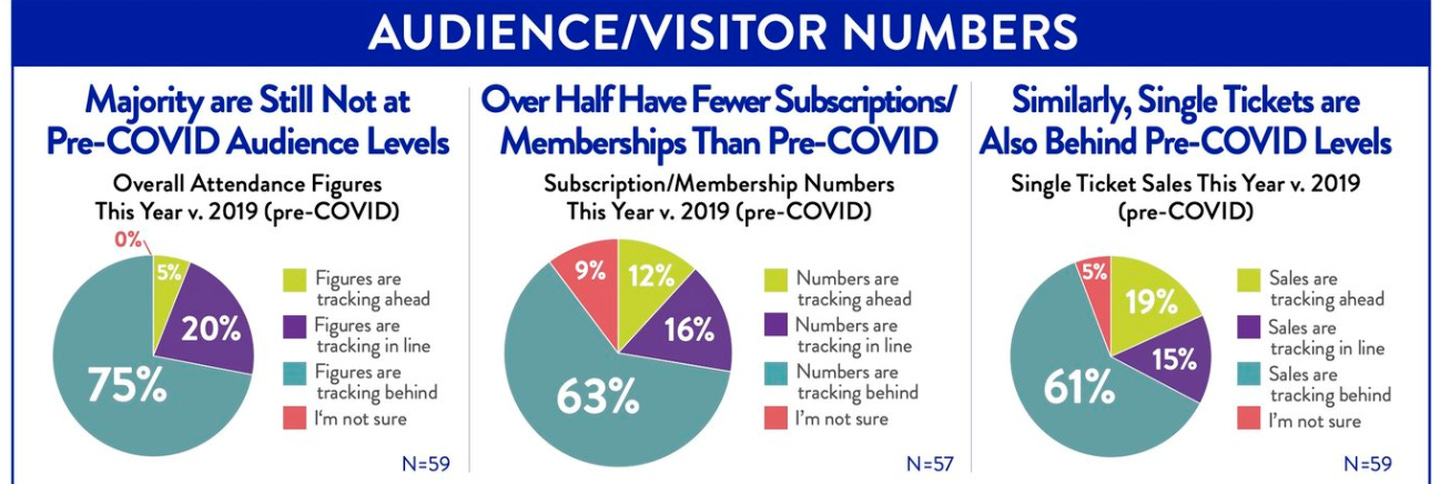Where has your audience gone? And why aren't they coming back?
Some pondering on the challenges the cultural sector is facing attracting and retaining audiences.
Over the past couple of years one refrain has been near constant, “we’re not seeing audiences coming back as we’d hoped”.
This has led to increasingly gloomy findings and headlines:
- Los Angeles Times: The theatergoing habit is broken. How do venues get people back in seats?
- The Audience Agency: Overall, people are still attending arts and culture less than they were before the pandemic
- New York Times: American Theater Is Imploding Before Our Eyes
- Campaign For The Arts: Attendance of most art forms has not recovered to pre-pandemic levels
- New York Times: 72 Regional Theaters, One Shared Crisis
And graphics like this:

Whilst the pandemic is often the thing people point a finger at, the seeds of these issues were sown long before.
In a piece (linked above) where he interviews 72 regional theater leaders, the New York Times’ Michael Paulson writes “The pandemic was an accelerant […] But the issues at the heart of this crisis — the aging of the audience, the growing role of streaming media in people’s entertainment diets, the decline in subscriptions as the way consumers plan their theatergoing — were underway before it.”
But audiences are still spending considerable time, money, and attention elsewhere.
- When releasing their Q2 2023 results, Live Nation’s CEO said “Live music is bigger than ever, with global demand driving the industry to record levels”.
- Netflix added almost 6 million new subscribers in Q2 of 2023.
- Taylor Swift’s Eras tour could become the highest grossing tour of all time.
- A couple of weeks ago I shared some data from the BBC which celebrated “record-breaking figures on iPlayer and BBC Sounds, with 93% capacity audiences” for the 2023 BBC Proms season.
- Global video game sales have also grown in 2023.
Baker Richards’ Director of Consulting Services, David Reece, makes a similar observation in a recent article for Arts Professional, “people are still prepared to spend on experiences even if they’re cutting back elsewhere”.
In this context the threat to cultural organisations is not other cultural organisations (fwiw from my perspective it never has been), but all the other ways that people are choosing to spend their time and attention.
Aubrey Bergauer has long written about how the arts need to change the way they market what they do, with an accompanying need to focus on the audience experience (Aubrey focuses specifically on classical music most of the time but her observations feel pretty applicable across performing arts as a whole).
In a recent article, Aubrey outlined 10 areas that she thinks arts organisations should be focusing on which included the urge to:
- Center the Customer
- Focus on Retention over Acquisition
- Use Digital Content to Drive Analog Attendance
- Expand the Audience to Look More Like Our Communities
- Engage in Advocacy
- Double Down on Pursuing Relevance
All of which are important considerations.

But I also believe there is a gap in the conversation around motivation and value.
Why would someone choose to spend their money on any one of the things mentioned above, but not on a trip to the ballet, opera, theatre, or orchestra? What are they getting there that they don’t get from you, or don’t think/feel they will get from you.
And, to speak to Aubrey’s point about retention, why are those people who do decide to try the arts for the first time then rarely, if ever, coming back a second time. How are we failing to motivate that reattendance?
It feels as though, with the sector in an understandable panic against a darkening economic backdrop of inflation, cost of living crises, decreases in funding, and ageing audiences, cultural organisations are perhaps not spending enough time understanding the root cause of the issue before jumping to attempted solutions.
I’ve written about this before:
Which is why it’s exciting to see this new research project from Indigo, “Tomorrow's Audience”. This project will aim to “Deepen[ing] understanding of first-time attenders to help cultural organisations develop the loyal audiences of tomorrow” with a specific focus to “Understand the drivers of reattendance in order to develop meaningful connections with new audiences and ensure they want to keep coming back”.
I’m intrigued to see what they discover.
With a similar sense of curiosity I’m excited that we will be joined at next year’s Digital Works Conference by author, Richard Shotton.
Richard’s book, The Choice Factory is a brilliant explainer of 25 behavioural biases that affect what we buy, and his background in behavioural research means I’m fascinated to hear his perspectives on the psychology of motivation.
You can buy your tickets to the conference now, and I’ll be keeping an eye out for the findings of Indigo’s research project in the coming months.